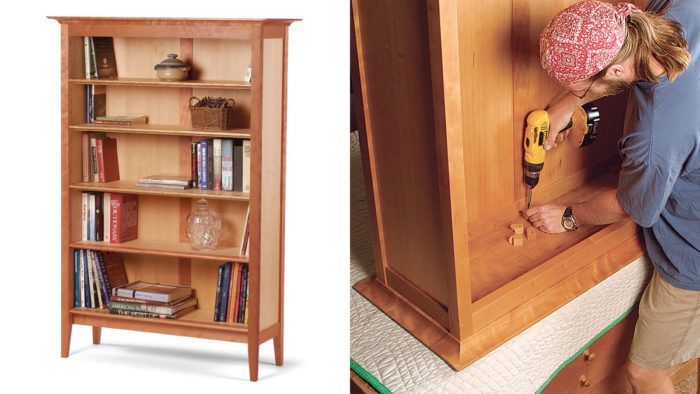Cherry and Fir Bookcase
Subtle details add elegance to a simple frame-and-panel design
Synopsis: The project plans and step-by-step instructions in this article will lead you through the process of building an attractive and functional bookcase of cherry and fir. Peter Zuerner designed this spare and elegant piece that he now regularly stocks in his furniture shop. He minimized the number of parts with frame-and-panel construction that integrates the four legs. He also explains how to cut cove molding with a router bit and a dado set on the tablesaw. Even when filled with books, this piece of furniture appears light and graceful.
Several years ago, my sister Cicely was looking for a bookcase that would be attractive, functional and reasonably easy to move. The piece I designed and built for her is now one of the stock pieces in my furniture shop. I call it, appropriately, Cicely’s Bookshelf.
I wanted the bookcase to have a spare and elegant look, so I kept the frame parts to a minimum and elevated the piece off the floor by extending the corner posts to create four short legs. All four edges of the top, along with the front edge of each shelf, were given a generously sized cove to create the illusion of thinner stock. As a result, even when the piece is filled with books, it appears light and graceful.
Choose the wood with care
For me, the first and most important step in any furniture project is the process of selecting the wood. Consistent color and grain are important, and I’m always on the lookout for something interesting. I especially like to incorporate special grain or a natural defect. Not only does an odd grain or a small defect make each piece a bit more unique, it also provides a strong visual connection to the tree from which it evolved. For instance, the piece shown here has a small, sound knot near the front of the lower shelf, about midway across the span.
In this piece, I liked the idea of blending darker cherry with the strong grain of quartersawn Douglas fir. So I used cherry for the frame parts, the top and the front edging on the shelves. The quartersawn fir is incorporated into the panels.
Sometimes, when wood is moved from one location to another, the new conditions of temperature and humidity can cause it to warp a bit, often within a few hours of the relocation. So once I have all of the oversize stock together in my shop, I like to give it a few weeks to acclimate to its new temporary home. Then, after rough-milling the stock, I allow it to sit for another day before cutting it to final size. Any last-minute twisting or cupping gets removed at this stage.
Construction is straightforward
I began by gluing up blanks for the 5/8-in.-thick side and back panels. To do that, I resawed 8/4 fir, book-matching the panels to add a balanced look.
All of the shelves were made from commercially available 5/4 by 12-in.- wide stair stock. However, the front of each shelf received an edging of 21/4-in.- wide cherry, so the bookcase ends up with an all-cherry look when viewed from the front. The cherry edging has another plus. Because fir sometimes can be splintery, the cherry almost eliminated any splitting out when the coves were cut.
From Fine Woodworking #161
For the full article, download the PDF below:
Fine Woodworking Recommended Products

Sketchup Class

Bessey EKH Trigger Clamps

Estwing Dead-Blow Mallet

Get the Plan
CAD-drawn plans and a cutlist for this project are available in the Fine Woodworking store.






















Log in or create an account to post a comment.
Sign up Log in